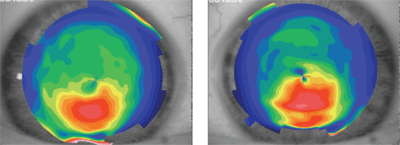 Keratoconus causes a steepening of the cornea, creating an irregular surface and an accompanying irregular refractive error. As the condition progresses, it becomes more difficult to correct the resultant refractive error with spectacles, and contact lenses often are the preferred method of correction. Most practitioners consider rigid gas permeable lenses the standard of care for the keratoconic cornea. While they work well at masking corneal irregularities, they often times require a significant adaptation period for patients to get “used to” the feel of them.
Keratoconus causes a steepening of the cornea, creating an irregular surface and an accompanying irregular refractive error. As the condition progresses, it becomes more difficult to correct the resultant refractive error with spectacles, and contact lenses often are the preferred method of correction. Most practitioners consider rigid gas permeable lenses the standard of care for the keratoconic cornea. While they work well at masking corneal irregularities, they often times require a significant adaptation period for patients to get “used to” the feel of them.
For keratoconic patients who appreciate the beneficial visual outcomes, but have difficulties in adjusting to lens awareness, lens dropout may be inevitable. Certainly for patients with significant comfort issues, large-diameter RGPs and hybrid lenses have allowed many with moderate to advanced keratoconus stay in lens wear. Additionally, new soft lens designs may challenge our current thinking on correcting the keratoconic patient. Here, we will review soft lens options along with two new keratoconic designs.
Mild Keratoconus
Those patients with mild corneal steepening will often times not necessarily require a specialty lens design. For those patients wearing soft contact lenses who show mild areas of steepening, transitioning them into a soft toric lens or increasing the power of the astigmatic correction if already wearing a toric lens typically will result in an improved visual experience. These usually are patients who will still have 20/20 visual acuity which is attainable with glasses but show early corneal steepening. For those patients who have a decrease in best-corrected visual acuity with traditional soft toric contact lens options, a specialty soft lens for keratoconus may be warranted.
NovaKone
The NovaKone is a unique design by Alden Optical that was introduced toward the end of 2011. It is a soft lens for keratoconus and is made of hioxifilcon D which is 54% water. It comes in a standard diameter of 15.0mm, but the diameter can be made larger or smaller, as needed. The sphere power availability is from +30.00D to -30.00D in 0.25D steps. Cylinder power availability is up to -10.00D in 0.25D steps from 1o to 180o. Additionally, the lens features five “It Factors” that define center thickness in order to neutralize irregularities.
Diagnostic fitting of the lens requires a four-step process. Initially, a base curve is selected on the average keratometry readings between the two meridians. (The base curve is the curve that is located on the center portion of the posterior surface of the lens.) The curve that is located more peripherally will be flatter than the central portion so that it aligns with the peripheral cornea and conjunctiva. This is termed the fitting curve. This curve can be altered independently of the central base curve. Diagnostic lenses feature a remarkably stable design to aid in over-refraction.

1. Topography scans of a patient who was fit with Kerasoft IC lenses (O.D. left, O.S. right).
The thickness of the lens can be manipulated for the more irregular cornea, making it a thicker lens to mask the irregularities. After the initial parameters are selected, the lens is placed on the eye. The base curve can be adjusted to provide an optimal optical surface and ensuring a light touch, while the fitting curve can be manipulated to optimize the fitting relationship of the lens on the eye. An over-refraction is performed, vertexed, and then the final lens is ordered. Alden Optical recommends the NovaKone be dispensed for quarterly replacement.1
Kerasoft IC
The Kerasoft IC is a unique new soft lens design for keratoconus and other corneal irregularities that is marketed by the Bausch + Lomb Boston Group and manufactured/distributed by selected laboratories throughout the world. This lens is made of the Definitive material, which is a new custom latheable silicone hydrogel material that has a water content of 74%.
The standard diameter is 14.5mm and its back surface is comprised of a large central curve and peripheral curve. The optic zone is 8mm in diameter and is located on the anterior surface of the contact lens. A unique characteristic of the design is the ability to make the whole peripheral area either steeper or flatter to achieve a better fitting relationship or to even make these changes in different sectors, if indicated.
The initial lens selection is based on the corneal shape, rather than simply curvature. As an example, there are different base curve guidelines for centrally located nipple cones than for inferiorly located cones. Thus, the initial base curve selected is not based just on corneal measurements, but is combined with the type, severity and location of the corneal irregularity.
Once the diagnostic lens is selected and placed on the eye, an assessment of the fit is performed within five minutes. It is advised to use the MoRoCCo VA guidelines developed to simplify the fitting process. It stands for assessing movement, rotation, centration comfort and vision. The ideal fit shows between 1mm to 2mm of movement with the blink, which is much more than we are accustomed to seeing with most soft lenses. Rotation is then assessed with stable 10o or less of rotation with the blink being the fitting goal.
The lens should center well, be comfortable while the vision attained with an over refraction is stable after the blink and close to best-corrected VA. If any of these fitting characteristics are not being met, it usually necessitates altering the base curve, while in some cases making the peripheral curve steeper or flatter will result in achieving an optimal fitting.2
Understanding new soft contact lens options for your keratoconic patients will help those who may have comfort issues with RGPs or those interested in other contact lens options. By embracing these new technologies, you offer your patients the opportunity to experience soft lenses to help correct their keratoconus and allow them the opportunity to continue wearing contact lenses.
Special thanks to Craig Norman, Bill Shelly and Tom Shone for their assistance with this article.
1.
www.aldenoptical.com
2. Kerasoft IC Fitting Manual


